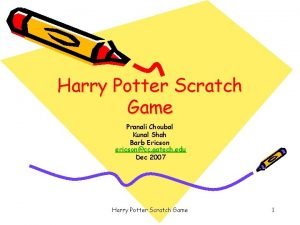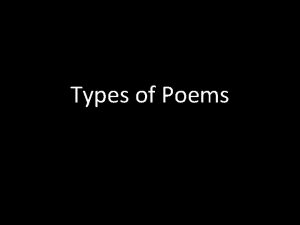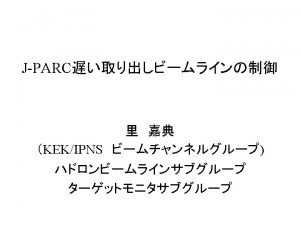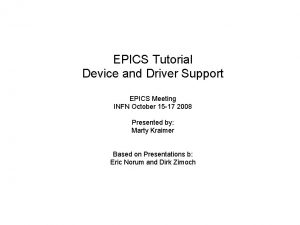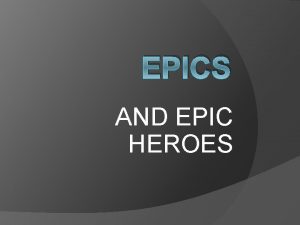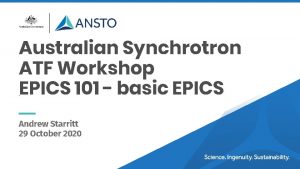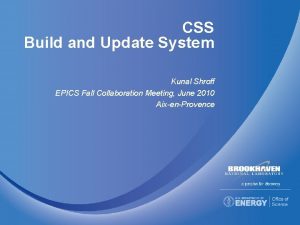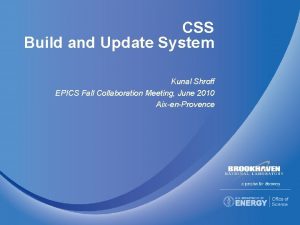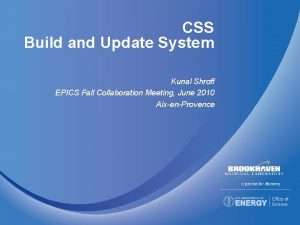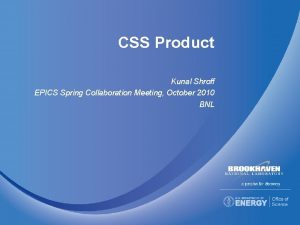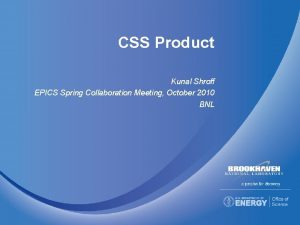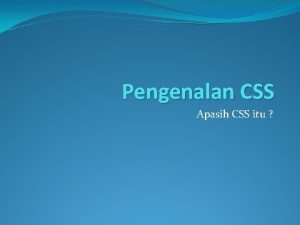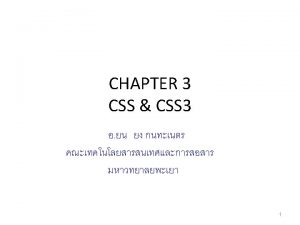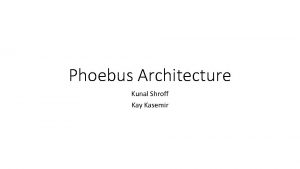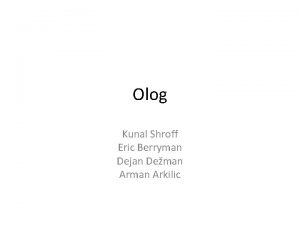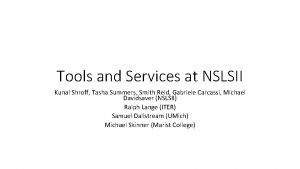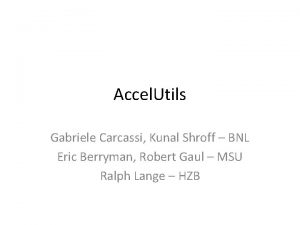Control System Studio CSS Kunal Shroff EPICS Training




















- Slides: 20

Control System Studio (CSS) Kunal Shroff EPICS Training Meeting 07/10/2010

CSS: Introduction • CSS is a common platform for new control system applications • CSS software is built on top of the Eclipse Rich Client Platform • Provides developers with management infrastructure and a centralised connection to external data sources.

CSS: installation • Step 1. Download css product based on your OS, site, requirement… o http: //cs-studio. sourceforge. net/ o • Step 2. o Unzip

CSS: installation • Why are there multiple CSS product’s ? o Site specific product § Set of applications § Configurations • Wiki o http: //sourceforge. net/apps/trac/cs-studio

CSS: Workspace • Stores configuration files o o CSS core plugins CSS applications/tools o http: //www. bnl. gov/epics/ → Agenda • One workspace each instance of CSS • Project and files can be shared between various instances • Training workspace

CSS: Perspectives • view • Editor • view

CSS: Help • Help->help contents • Search • Browse

CSS: Probe • CSS→Diagnostic Tools →Probe • basic reading and writing of Process Variables (PVs). o o o Caget Caput Camonitor

CSS: EPICS PVtree • Displays the hierarchical data flow between EPICS records. • displays o o record types alarm servertity

CSS: Best OPI Yet (BOY) • BOY is an Operator Interface (OPI) development and runtime environment. • Developed at SNS by Kasemir & Xihui Chen • BOY is integrated in CSS • Runtime o o Web-Browser like navigation Scalable o o Easy to use Simplified Dynamic support (rules) • Editor

CSS: BOY Editor Perspective CSS → Display → OPI Perspective

CSS: BOY Runtime Perspective

CSS: BOY Widgets • Graphics: The graphics widgets can help you decorate your OPI. (Image, arc, rectangle) • Monitors: The widgets that can graphically display the value of PV in various ways. (Text update, meter) • Controls: The widgets by which you can make control operations directly. (action button, text input) • Others: The other widgets which is not in the three major categories. (web Browser, linked container)

CSS: BOY getting started • Create a simple OPI with Text Update widget using a simulated pv (sim: //noise) • sim: // § Simulated PVs can have these formats: sim: //noise generates simulated noise from -5 to 5, updating once every second. § sim: //noise(-10, 0. 2) generates simulated noise from -10 to 10, updating every 0. 2 seconds. § sim: //sine(0, 10, 20, 0. 5) generates a simulated sine wave signal valued 0 to 10, split into 20 updates, updating every 0. 5 seconds. A full period takes 20 updates, i. e. 5 seconds in this example. § sim: //ramp(0, 10, 0. 1, 0. 5) generates a ramp (saw-tooth) valued 0 to 10, stepping 0. 1 every 0. 5 seconds.

CSS: BOY getting started • Connect to the ${P}: count • Use Text Input widget to change o o Set size (INPB) Function (CALC) • Add a menu button to change SCAN rate • Add action to reset the count

CSS: BOY getting started • XY chart widget o o o Scalar and waveform records line chart, scatter chart, bar chart, step chart, area chart. . . Abundant interactive operations Configure properties during running log scale, date time format o o Set PV Name to ${P}: hist Uncheck concatenate under the trace properties • Use the XY chart to monitor the Gaussian waveform

CSS: BOY is that it? • Dozens of widget • Actions, rules and script framework to support dynamic operations • Integrated with the CSS tools • Extensible with custom widgets

CSS: BOY Self-Training Resources • BOY Homepage o http: //sourceforge. net/apps/trac/cs-studio/wiki/BOY • Examples o CSS->Display->Install OPI Examples • Help o Help->help Contents

CSS: If you liked this you might like • Thursday 14 October 2010 o o CSS overview & update BOY (OPI) BEAST (Alarm System) Channelfinder Viewer

Questions
 Css epics
Css epics Epics control system
Epics control system Gautam shroff tcs
Gautam shroff tcs Um college of pharmacy
Um college of pharmacy Kunal talwar
Kunal talwar How to make a harry potter game on scratch
How to make a harry potter game on scratch Dr sheena patel
Dr sheena patel Lipa library
Lipa library Xna game studio visual studio 2017
Xna game studio visual studio 2017 Xbox xna
Xbox xna Free verse poem
Free verse poem Epics channel access
Epics channel access Epics database
Epics database Most famous epics
Most famous epics Important facts about beowulf
Important facts about beowulf The earliest known grecian epics were written by____ .
The earliest known grecian epics were written by____ . Epics driver
Epics driver Why do epic heroes have supernatural powers
Why do epic heroes have supernatural powers Epics calc record
Epics calc record Epics sequencer
Epics sequencer Epics caget
Epics caget





